
|   |

|   |
 e-mail: janakipatrik@gmail.com We Sinful Women March 5, 2025 We Sinful Women / Hum gunah gaar aurtein hain © Kishwar Naheed It is we sinful women who are not awed by the grandeur of those who wear robes who don't sell our lives who don't bow our heads who don't fold our hands together. It is we sinful women while those who sell the harvests of our bodies become exalted become distinguished become the just princes of the material world. It is we sinful women who come out raising the banner of truth up against barricades of lies on the highways who find stories of persecution piled on each threshold who find that tongues which could speak have been severed. It is we sinful women, Now, even if the night gives chase These eyes shall not be put out For the wall which has been torn down Don't insist now on raising it again. It is we sinful women who are not awed by the grandeur of those who wear robes who don't sell our lives who don't bow our heads who don't fold our hands together. Inspiration I was initially inspired by the Urdu words of Pakistani feminist poets in 1993, when I read a few of their poems from the collection edited and translated by Rukhsana Ahmad and titled WE SINFUL WOMEN. Those poems had been included in the readings for Professor Gauri Viswanathan's Columbia University course, Nationalism and Modernity, in which I enrolled as part of my MA program in Indic languages and cultures. Simultaneously, I met Naseem Khan, whose May 1976 Report to the Arts Council of Great Britain, titled "THE ARTS BRITAIN IGNORES, The Arts of Ethnic Minorities in Britain", had revealed the inherent racism and myopia of arts policy in this leading nation of the western world. Dropped like a bomb on complacency, Ms. Khan's report started a process of examination of Britain's debts to its former colonies - in this case to its citizens whose ancestral roots were in former colonies of the British Empire, and whose cultural lives in their transposed British homeland were not being supported. Naseem and I developed a friendship, and we embarked on a continuing dialogue on feminism, non-western arts and culture, and political policy. As an offshoot of our discussions on feminism, Naseem sent me a copy of the book WE SINFUL WOMEN. [1] After reading the entire collection of poems, I was inspired to create a dance production illuminating their messages. But the 1990's arts world was ablaze with vitriolic name-calling and mutual misunderstanding. "Appropriation" was a popular term used to criticize and discredit even those western artists whose training had grounded them in non-western arts. In addition, the term "authenticity" - often based on outward appearance rather than artistic merit -- was used as another weapon against artists whose ethnicity was not aligned with that of the art they practiced. And so, considering the dark cloud of "appropriation" and "in-authenticity" hanging over artists like me, I chose not to step into the fray in 1993. Moreover, under the shadow of the United States' 1982 failure to pass the Equal Rights Amendment, I did not feel entitled to express the Urdu feminist poets' words, which protested the suppression of women in Pakistan. What right had I to expose Pakistan's political policies and social traditions which repress women and girl children, when the United States still had not established a simple law to guarantee the most basic rights of women? The following are the words of the draft of The Equal Rights Amendment to the United States' Constitution: Section 1: Equality of rights under the law shall not be denied or abridged by the United States or by any state on account of sex.Short and concise. Seemingly unthreatening. But apparently alarming to the reigning patriarchal mindset of the 20th and 21st centuries. Consequently, the need still remains to speak out in whatever medium can protest repression of the female half of the world's population. Protection of women's rights still needs to be guaranteed by law in the United States' Constitution, and in the laws of multiple other countries. Decision In 2017, artistic inspiration and historical circumstances impelled me to drop my reservations about creating a production based on poems chosen from the collection WE SINFUL WOMEN.1 I contacted my Urdu language mentors, Dr. Tahira Naqvi [2] and Dr. Frances Pritchett [3], and I engaged the brilliant composer Kiran Ahluwalia [4]. The poems illuminated in my production would not represent a political diatribe. Rather, in music, poetry and movement, they would express the tenderness and enduring strength of all women as equal members of the human family.
HIGHLIGHTS Video vimeo.com/208580217/9a1e6b88eb NOTE - If Vimeo does NOT play simply by clicking on the link, then copy and paste the link into your browser. Then click. Process Choreography & Costuming All photos by the late Darial Sneed except where otherwise attributed Having chosen poems on the basis of the richness of their imagery and the contemporary relevance of their messages, I went through a process of creating a cohesive order. Of course, the choice of poems and their order of performance changed over time. Originally, I thought the title poem of the collection - We Sinful Women - should open the performance. But by opening night, this poem closed the show in a celebratory mood of defiance and female solidarity. In their final sequence the poems followed a loose progression from birth of a girl child to celebration of women, who are "sinful" only because we insist on equality.  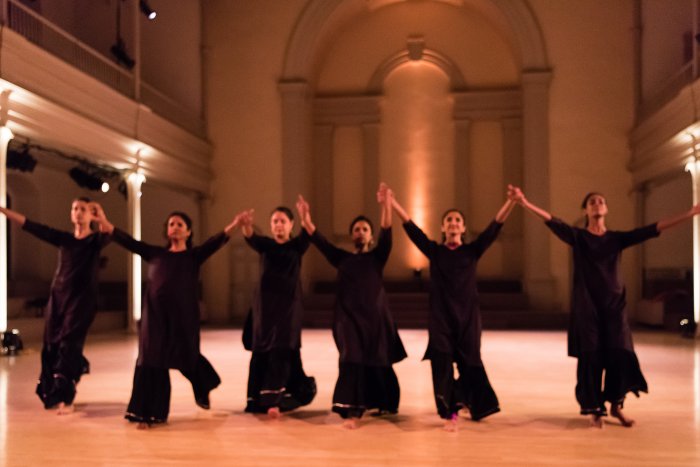 In the course of creating this production, I met several times with Dr. Pritchett and weekly from September to March with Dr. Naqvi, discussing the historic contexts and shades of meaning of each word in each poem. In this process, I had many questions. Could I include poetry about blood, which is an essential part of a woman's monthly experience of her body preparing to give birth to life? (I did not include any such poems.) And how could I create movement for the words of the azan which opens Fahmida Riaz's poem O God of Heaven and Earth? I did not want to provoke accusations of blasphemy from the orthodox Islamic world, which prohibits dancing, especially that which emphasizes the female body. (The solution: The dancers and I created images of the natural world and of praise of the ultimate.) Allaa ham dul illaa rabal aalaamiin 'Praised be God, the God of all the worlds Sab taariif khudaa ki hai jo hai baha azeem All praise to God who is very great.'  Each poem elicited discussions about cultural, linguistic and gestural boundaries. How literally should the dance movements interpret the words? And since veiling and unveiling and re-veiling of women has been such a central issue during eras of Pakistani modernization then political retraction then reinstatement of liberal policies, should costuming be based on the hijab and jilbab, or some suggestion of these traditional and periodically contentious pieces of clothing? (I even went to stores in Jackson Heights, Queens and bought six hijab, so that the dancers could take them home, wear them and decide for themselves whether they felt culturally comfortable moving in them. PS: They did not.) Eventually, we collectively decided on a plain black sharara and kurta. Our costume designer Anna Alisa Belous added colorful pieces of cloth, which would change the mood or symbolic representation according to the text of each poem - gold for the "tiny ray of light" at the birth of the girl child (First Prayer of My Elders);
The exception to this basic costume concept was the costuming for the 18th century ghazal by Lucknavi poet Jur'at (Saropa - the Man Speaks). In contrast to the basic black worn for all other poems, bright silk angarkha were worn for this seductive poem, demonstrating the atavistic tastes of patriarchal society.
In fact, inclusion of this ghazal had led to one of the most niggling quandaries in the process of selecting poems. When I began studying Kishwar Naheed's masterful nazm Anticlockwise, I realized that it was written in the form of a so-called Urdu saropa [5], known in the repertoire of Lucknow gharana Kathak as nakh-shikh [6]. Both saropa and nakh-shikh traditionally enumerate intimate attributes of a woman's beauty, from toenail (nakh) to head (sir), often described from the man's lascivious point of view. The dilemma arose, because I had conceived the unity of this production to be based on selection of poetry exclusively from the collection, WE SINFUL WOMEN. Yet Anticlockwise brought to mind an 18th century ghazal written by the Lucknow poet Jur'at. I remembered this saropa ghazal from a presentation by the Urdu scholar Mehr Afshan Farooqui at a 2006 workshop at Columbia University entitled Sarapa and Nakh-Shikh Varnan. In 2017, when I wrote to Dr. Farooqui and asked her about Kishwar Naheed's nazm, she replied, "Kishwar Naheed's poem is not exactly a sarapa, although it does start with the eyes, and goes to nose and lips. It is exactly what she calls it -- ĎAnti clockwise' or anti sarapa!" In view of this concurrence of literary forms, I decided that Jur'at's ghazal saropa should be juxtaposed to Kishwar Naheed's nazam Anticlockwise. The contrast would highlight stark difference between the paternalistic and feminist gaze. 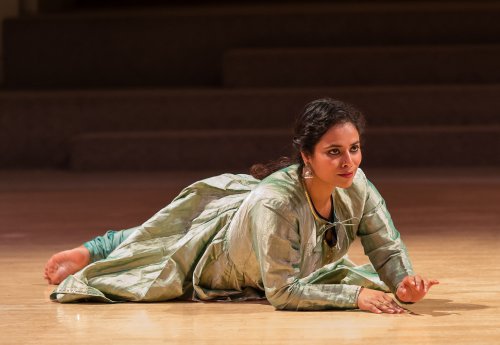 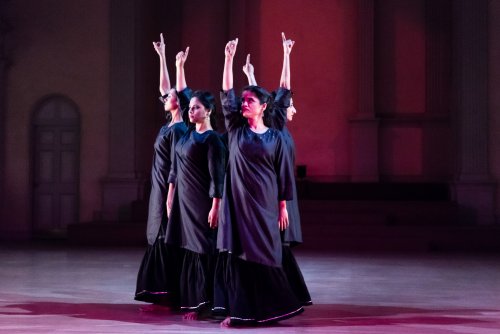
Music composition During my initial meeting with composer Kiran Ahluwalia, I learned that she would be on tour at the time of our non-negotiable performance dates. Though I was disappointed at first, this situation turned out to be a big benefit. To engage so many musicians for rehearsals and performances, scheduling and budgeting would have been a logistic nightmare. Instead, two rehearsals prior to two recording sessions resulted in top quality music. Kiran is not only a master composer, but also a very skilled rehearsal director. An additional advantage is the expansion of the vocabulary of sound effects. For example, I wanted the production to open with chords to establish an atmosphere of sacred wonder. A solo vocalist cannot sing chords, but the computer can superimpose multiple, overlapping swars (notes), thus creating a chord "sung" by one voice. I also wanted the Anticlockwise refrain, "even so the fear will not leave you" to be sung backwards. Kiran of course did just that... "You leave not will fear the so even", but to add to the effect, the computer played the refrain track backwards at very high speed, which sounded like a needle being dragged across a record.  To accommodate Kiran's busy touring schedule, she and I communicated mostly by phone and email. We developed an informal methodology, beginning with discussions of the interpretations and mood of each poem. For a few poems, I had clear ideas - for example that WE SINFUL WOMEN should be a march, and that O GOD OF HEAVEN AND EARTH should have a distinct break of melody and dynamic to separate its two distinctly different moods. Kiran translated those ideas into music, to which each musician added his improvisations where appropriate. For example, Steve Gorn played a klezmer-like dirge on his clarinet as a transition from the beauty of the night to the pleading silent voices of women knocking on the locked doors of their hearts. If only someone would come, if only someone would come and knockRamesh's soulful accompaniments on sarangi and Quraishi's folk improvisations on the rubab created moods by the very nature of their instruments. Nitin Mitta and Rich Stein's vast vocabularies of percussive sounds laid distinct rhythmic foundation for each poem. Kiran speaks and reads Urdu, and she is a classically trained Hindustani singer. Her melodic creativity flows profusely. For every poem, Kiran would send me choices of opening lines in at least two different ragas (melodic modes) and layas (tempos), and sometimes even different talas (time cycles). During our initial discussions, I described how my productions interwove original Indic languages with English. In this way, the beauty of languages could be heard, but the meanings could be understood by English-speaking audiences. English was placed uniquely in each poem, and the process was facilitated by the honeyed voice of Manoshi Chitra Neogy. Recording session # 1 - 10 October 2016 Recorded at East Side Sound Studios Marc Urselli: Recording Engineer Kiran Ahluwalia: vocal & English recitation Steve Gorn: bansuri, clarinet, soprano saxophone Pt. Ramesh Misra: sarangi Nitin Mitta: tabla Quraishi Roya: rubab Rich Stein: percussion  L to R - Kiran Ahluwalia - Janaki Patrik - Quraishi Roya - Steve Gorn - Pt. Ramesh Misra - Nitin Mitta - Rich Stein Recording session # 2 - 14 February 2017 Recorded at East Side Sound Studios Marc Urselli: Recording Engineer Kiran Ahluwalia: vocal & English recitation Steve Gorn: bansuri, clarinet, soprano saxophone Pt. Ramesh Misra: sarangi Nitin Mitta: tabla Samarth Nagarkar: vocal and English recitation Manoshi Chitra Neogy: English recitation Quraishi Roya: rubab Rich Stein: percussion 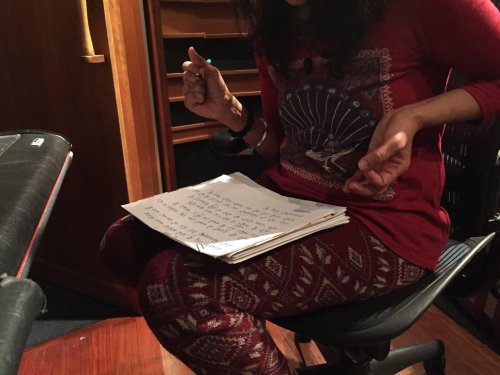 Kiran looking at her session notes as she conducts the recording Performances The Kathak Ensemble & Friends JANAKI PATRIK, Artistic Director present WE SINFUL WOMEN March 2, 3, 4, 2017 at 8pm DANSPACE PROJECT ST. MARK'S CHURCH IN-THE-BOWERY 131 East 10th Street, New York, NY 10003 Based on poems chosen from WE SINFUL WOMEN A collection of contemporary Urdu feminist poetry, edited & translated by Rukhsana Ahmad Choreography by Janaki Patrik with the dancers ~ Aditi Dhruv ~ Kanushree Jain ~ Megha Kalia ~ ~ Romanee Kalicharran ~ Bharathi Penneswaran ~ Saloni Somani Original music by Kiran Ahluwalia Commissioned by The Kathak Ensemble Recorded by Kiran Ahluwalia: vocal & English recitation Steve Gorn: bansuri, clarinet, soprano saxophone Pt. Ramesh Misra: sarangi Nitin Mitta: tabla Samarth Nagarkar: vocal & English recitation Manoshi Chitra Neogy: English recitation Quraishi Roya: rubab Rich Stein: percussion 1. FIRST PRAYER OF MY ELDERS - written by Ishrat Afreen "... In my very first breaths it stirred - the bitter poison of defeat as I heard: 'Oh, it's a girl!'... " Danced by The Ensemble Performances of this dance are dedicated to the memory of Shrimati Mangani Ramdayal (1933 - 2016) - grandmother of dancer Romanee Kalicharran 2. COMPROMISE - written by Zehra Nigah " ...This chaadar of warm, soft compromise has taken me years to weave. ... With this chaadar I can cover my body and you also will be satisfied. We will not be happy, but neither will we be miserable ..." Danced by The Ensemble 3. IMAGE - written by Fahmida Riaz "Deep in the recesses of my heart hangs a picture of myself. God knows who painted it and when. There it remains hidden from me and my friends. But if ever I glimpse at it, even by accident, my heart trembles at the comparison with myself." Danced by Romanee Kalicharran & Saloni Somani 4. O God of Heaven and Earth - written by Fahmida Riaz " ... Why do my prayers become meaningless on my lips, as if all within me were desolate and uninhabited. ... if only someone would come and knock ... How can I open the locked doors of my heart?" Danced by The Ensemble 5. SAROPA / From Head to Toe - The Man Speaks Selected shers from a GHAZAL * by Qalandar Bakhsh JURAT (b. Delhi 1748, d. Lucknow 1809/10) " ... So plump and soft your thighs and calves, such feet that even anklets seek to clasp...." Danced by Aditi Dhruv & Bharathi Penneswaran * Translated by Mehr Afshan Farooqui. Quoted by permission of the translator Link 6. ANTICLOCKWISE / From Head to Foot - The Woman Answers - written by Kishwar Naheed " ... Even after you have tied the chains of wifely duties, shame and modesty around my feet; even after you have paralyzed me, even then this fear will not leave you -- that though I cannot walk, I can still think...." Danced by Aditi Dhruv - Megha Kalia -Romanee Kalicharran - Bharathi Penneswaran - Saloni Somani Performances of this dance are dedicated to the memory of Marjorie Gamso (1944 - 2011). In her choreography, whatever could be danced forward, could also be rewound backward. 7. MIGRATION - written by Ishrat Afreen " ... She left home in the pink of her youth - that silken girl from the tribe of Stones And arrived into the tribe of love." Danced by Megha Kalia 8. WE SINFUL WOMEN - written by Kishwar Naheed " .... It is we sinful women, who are not awed by the grandeur of those who wear robes who don't sell our lives - who don't bow our heads - who don't fold our hands together." Danced by The Ensemble 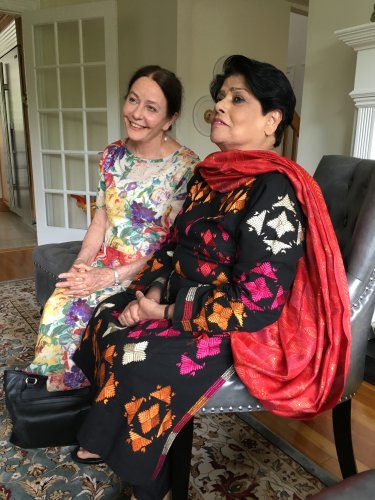 2017-07-08-Kishwar Naheed & Janaki Patrik at Professor Tahira Naqvi's home. Photo by Shehla  Trained in both classical Kathak dance (Pt. Birju Maharaj, beginning 1967) and Merce Cunningham modern dance technique (1971 to 1978), Janaki Patrik has choreographed thirty full-evening productions and numerous shorter works exploring an eclectic range of poetry, mythic storytelling and music. She is the Artistic Director and Founder (1978) of The Kathak Ensemble & Friends/CARAVAN, NYC. A dedicated teacher, Janaki has trained dancers to perform an extensive repertoire of classical Kathak, as well as her new choreography. Teaching and performing in inner-city schools through Urban Gateways / Chicago and Young Audiences / New York for forty years, Janaki has embodied the power of dance and music to communicate the interconnections of all cultures. Post your comments Please provide your name along with your comment. All appropriate comments posted with name & email id in the blog will also be featured in the site. |